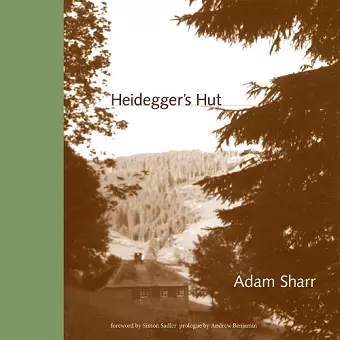Heidegger's Hut
Format:Paperback
Publisher:MIT Press Ltd
Published:24th Feb '17
Should be back in stock very soon

Heidegger's cabin in the Black Forest has been the focal point of his work, and it has been shrouded in mystery and rumor. Adam Sharr has cast on it the light of diligent research, architectural expertise, and liberal judgment, and he has given us a clearer idea of where Heidegger's thought has come from. -- Albert Borgmann, Regents Professor of Philosophy, The University of Montana
The intense relationship between philosopher Martin Heidegger and his cabin in the Black Forest: the first substantial account of "die Hütte" and its influence on Heidegger's life and work.
The intense relationship between philosopher Martin Heidegger and his cabin in the Black Forest: the first substantial account of "die Hütte" and its influence on Heidegger's life and work.
"This is the most thorough architectural 'crit' of a hut ever set down, the justification for which is that the hut was the setting in which Martin Heidegger wrote phenomenological texts that became touchstones for late-twentieth-century architectural theory."
—from the foreword by Simon Sadler
Beginning in the summer of 1922, philosopher Martin Heidegger (1889-1976) occupied a small, three-room cabin in the Black Forest Mountains of southern Germany. He called it "die Hütte" ("the hut"). Over the years, Heidegger worked on many of his most famous writings in this cabin, from his early lectures to his last enigmatic texts. He claimed an intellectual and emotional intimacy with the building and its surroundings, and even suggested that the landscape expressed itself through him, almost without agency. In Heidegger's Hut, Adam Sharr explores this intense relationship of thought, place, and person.
Heidegger's mountain hut has been an object of fascination for many, including architects interested in his writings about "dwelling" and "place." Sharr's account—the first substantive investigation of the building and Heidegger's life there—reminds us that, in approaching Heidegger's writings, it is important to consider the circumstances in which the philosopher, as he himself said, felt "transported" into the work's "own rhythm." Indeed, Heidegger's apparent abdication of agency and tendency toward romanticism seem especially significant in light of his troubling involvement with the Nazi regime in the early 1930s.
Sharr draws on original research, including interviews with Heidegger's relatives, as well as on written accounts of the hut by Heidegger and his visitors. The book's evocative photographs include scenic and architectural views taken by the author and many remarkable images of a septuagenarian Heidegger in the hut taken by the photojournalist Digne Meller-Markovicz. There are many ways to interpret Heidegger's hut—as the site of heroic confrontation between philosopher and existence; as the petit bourgeois escape of a misguided romantic; as a place overshadowed by fascism; or as an entirely unremarkable little building. Heidegger's Hut does...
As Adam Sharr reveals in his remarkable study Heidegger's Hut, the philosopher's timber-shingled cabin (which had no running water and, at least for the first decade, no electricity) can be interpreted as a locus of contemplation, a romantic escape, and a place where, given the politically problematic nature of Heidegger's writings, fascist over-tones cannot but linger.
-- Andrea Walker * Bookforum *Heidegger's Hut, a slim, provocative volume, answers the question: why the architectural interest in the drab, three room, 20-foot square Black Forest hut without running water or electricity inhabited by the German philosopher Martin Heidegger throughout his career?
-- Norman Weinstein * Architectural Record *Heidegger's Hut is and is not a book about a hut. It's about how a place inspired a life's work, and how that work inspired modern architectural theory and, to a lesser degree, the sustainability movement...Many of the book's photos are posed, though the light is beautiful. The hut has a confidence, a rightness that is oddly indisputable, making in the end, even the philosopher's work seem transient and insubstantial.
* The Los Angeles TimISBN: 9780262533669
Dimensions: 191mm x 191mm x 8mm
Weight: unknown
168 pages